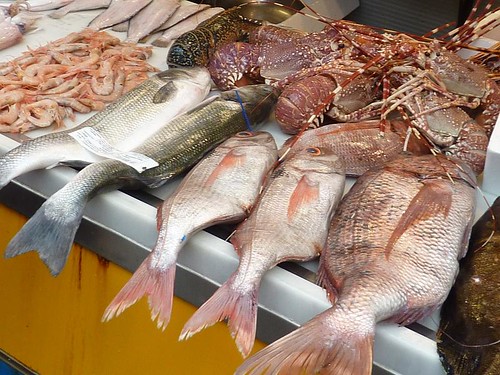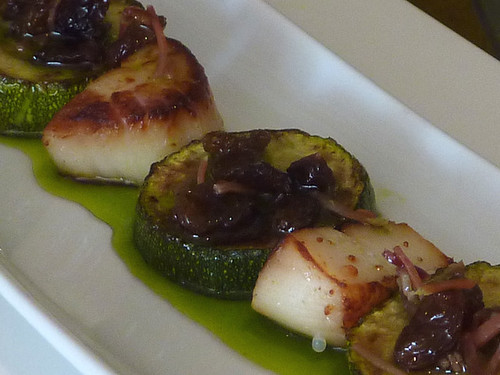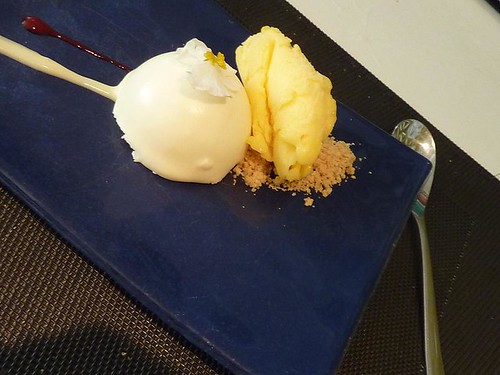Yes, it is possible. You have to try hard, but there are alternatives to English pubs selling fish and chips and Sunday roast with all the trimmings, and Spanish bars selling stodgy food swimming in olive oil and garlic (not that I have anything against olive oil and garlic when they are used well and don’t swamp every other flavour). Here are our tips from two months’ eating around Málaga.
We’d already decided that the rule that normally applies in France to find good-value restaurants (follow the local businessmen at lunchtime) doesn’t work in Spain. It’s better to follow the tourists. But that technique doesn’t seem to work either in the attractive resort of Nerja. The Balcon de Europa is a lovely, broad esplanade on a headland with beautiful sea views. It’s surrounded by bars and restaurants which are always crowded with tourists eating what looks like frankly indifferent and overpriced food. We found our absolute favourite restaurant in Nerja (and indeed in the whole of the province of Málaga) by the unorthodox method of spotting a classy modern business card among the sea of garish red and yellow restaurant flyers in the tourist office. Passing from the crowded Balcon through a deserted shopping arcade, we arrived at Oliva at the very reasonable Spanish hour of two o’ clock on a sunny Sunday in June to find it completely deserted. We even asked the waitress if it was actually open.
Despite the unpromising start, we thought we’d give it a try anyway because the menu looked interesting, and we were not disappointed. Everything was excellent, but the standouts were the small things. To start, the friendly Dutch waitress brought a basket of warm, fresh bread served with a dish of olive oil and a little pot of herb butter topped with finely chopped black olives. One taste of this butter, and we were hooked. I don’t think it was entirely because being in southern Spain we’d eaten virtually no butter for a month. There must have been 50 g of butter in that pot and we ate the lot between the two of us, using tiny pieces of bread purely as supports, and slathering them with large dollops of butter.
The “pre-starter” of Parmesan crisps with tomato jam was good too, and we loved the little palate-cleaning scoop of mint granita between courses. The tomato tart I had as a starter wasn’t exceptional, but it was attractively presented, and perked up with a good home-made tartare sauce. One of my pet annoyances in Spanish restaurants is having to make your own vinaigrette when the salad is already on the plate, but at least the waitress brought a small can of organic olive oil, and a spray bottle of balsamic vinegar for my main-course salad with fried feta cheese (yes, I was easily able to order a vegetarian meal in a Spanish restaurant!). And the panna cotta lived up to our exacting standards.
We liked the pacing too, more French style than Spanish, with time to relax and chat between courses. It’s not the cheapest (our meal cost 87 euros including a bottle of very nice Chardonnay), but the quality and style of cuisine made it worth every penny. We liked it enough to go back in our last week, on a Wednesday evening in July when there were all of five other diners. I was glad to note that we weren’t the only ones using bits of bread to scrape every last smear of butter out of the pot, and gazing at it regretfully when it was empty. Now I’m making it my mission to tell everyone about Oliva, because I want it to still be open if we are ever back in Nerja. It’s only been open six months, and it deserves to be more popular than it apparently is.
Here is a whole load of other restaurant suggestions for Nerja. I haven’t tried any of them, but several sound promising. Comment if you’ve tried one of them! The one other place we ate at in Nerja and liked isn’t mentioned there: the Casa Luque, just off the Balcon de Europa. We’d asked in the tourist office for somewhere that served local ingredients in a modern way, and this fitted the bill. We had a tapas-based lunch here twice; it’s pricier than the other tapas places around there, but more refined.
Our other outstanding restaurant experience was in Málaga. This one we found by chancing on a feature in that day’s paper as we drank coffee in a bar. “This sounds good,” said my husband. “Let’s have lunch there.” So on no more evidence than that, we walked there through the lovely botanical garden and found La Moraga, a trendy tapas lounge on the beach, but a far cry from the average chiringuito (beach bar) in all other respects.
In Spanish style we ordered four separate dishes, specifying that we wanted to share all of them. So we started with two glasses of a delicious gazpacho featuring cherries (allegedly, they were hard to detect), pistachios, anchovies, and a scattering of cheese, and a little pot of very nice foie gras with toast and cubes of membrillo — it wouldn’t have occurred to me to pair membrillo with foie gras, but it went really well. Then we had a dish of grilled scallops with courgettes, Málaga raisins, and basil oil, and half a grilled lobster on a gorgeous, creamy potato purée — we fought over the last dregs of potato, wiping the dish out with our bread. Maybe it had butter in it.
Even the desserts were fab — biznaga, a globe of airy mousse filled with membrillo, and — yes! — torrija, my favourite Spanish dessert, made with coconut milk and white chocolate. The portions were tiny, and it was really expensive — 14 euros for three scallops and three slices of courgette is a bit over the top, and one dessert cost as much as an entire lunchtime menu at our local bar, with the total bill coming to 90 euros — less good value than Oliva since we ate less food. But as at Oliva, it was such a pleasure to eat modest quantities of imaginatively and perfectly cooked food, instead of big piles of greasy stodge; in addition it has a view of the beach and very pleasant staff.
Note, I’m not linking to their website in protest at it encapsulating almost everything that is wrong with restaurant websites: no address, opening hours, or phone number on the home page, everything in flash, navigation items that skitter away when you try to click on them, no sample menu, and despite their prices they haven’t been able to pay someone competent to translate their site into correct English. The only thing they’ve missed is cheesy music. Instead here’s a picture of the park.
I’ve already mentioned why I don’t like the more downmarket Spanish restaurants. But if your budget doesn’t run to Oliva or La Moraga prices, I have one tip for eating cheaply on the Costa del Sol: fried fish. Everywhere around Málaga that we ate deep-fried fish, it was superb. They really know how to do it to perfection: very fresh, hot and crispy. And, paradoxically, much less greasy than anything cooked a la plancha. After Oliva, my favourite place to eat was at our local bar, where a menu del dia with drinks and coffee costs just 7.50 euros. So here’s a shout-out for the Bar Lopez in Almáchar. Go on a Friday for Paco’s mum’s paella, cooked in her kitchen and carried down the street in its pan by two sturdy men. This is true Spanish paella, with lots of rice and just a few prawns, mussels, clams, and small pieces of diced chicken. You eat it as a starter, with a green salad that actually has vinaigrette on it.
Then have a big plate of crispy fried squid, bacalao, or rosada (a local white fish) with a squeeze of lemon and some garlic mayonnaise. To drink: tinto de verano, beer, or the house white, a fruity white verdejo from Rueda that goes perfectly with the fish. Don’t bother with dessert (this is a good rule to follow in all but the most expensive Spanish restaurants). You won’t do as well as this at every bar, but in a village setting it’s easy to identify the bar that serves the best-value lunch: just follow the crowds at 2 pm. And it’s likely to be better value than any traditional restaurant; steer clear of anything with Mesón in the name, as this seems to be code for “We’ll serve you overpriced, greasy stodge”.





I saw your link on Slow Travel and was curious about what you might recommend in Málaga. I live in Sevilla but get down to Málaga at least once a year and have “discovered” a lot of great places to eat there. I’ll be back in August and want to try out the new La Moraga location (there is also one in the centre of town) – but I think I’ll stick to tapas.
Just one thing I thought I’d mention is that rosada isn’t a local fish. It’s caught off the coast of either Chili or Argentina and brought to Spain already frozen. It’s very popular here though, which may give the impression that it’s local.
If you’d like to see some of my Málaga picks have a look here:
http://www.azahar-sevilla.com/vivalastapas/?cat=3
Oh, and I agree with you wholeheartedly about restaurant websites that don’t give you the basic information you are looking for. The drive me nuts.
Thank you, Azahar! Rosada was so ubiquitous, I thought it must be local, but you’re right — I only ever saw it frozen in the supermarkets 🙂 The fish in the last photo are jureles in Málaga market, by the way — so fresh they are still stiff!
Thanks for the recommendations too — we didn’t spend much time in Málaga because it was a bit of a trek from our mountain hideaway (nearly an hour’s drive each way), but I wish I’d had your list 🙂 We did eat a light lunch at El Pimpi — we found it a bit overpriced for what it was, but the fried boquerones were of course excellent.
You should have tried “Los Mellizos” in the centre of Málaga, behind MacDonalds, it is extremely popular, fish, shellfish and paellas, excellent quality for money and good atmosphere, and just next door you have “Gin Tonic” if you want to carry on the party
Glad I’ve discovered your site – I don’t recall seeing a link on your BF profile.
Didn’t realise you had spent so long in Spain – what fun. Seems you had a mixed experience with the cuisine! I have to say you do need to do the homework which you clearly have done, as otherwise things can be dull, but I have to say things are pretty good in Malaga now – but sadly expensive!